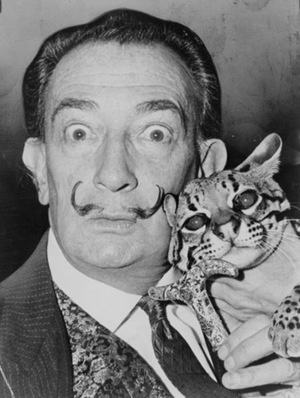Salvador Domingo Felipe Jacinto Dali y Domenech was born at 8:47 AM on May 11, 1904. He was born in the small town of Figueres, Spain which is situated in the foothills of the Pyrenees and is just 16 miles away from the French border. His notary father was named Salvador and his mother was Felipa Domenech Ferres.
Interestingly, Salvador’s brother had passed away less than one year before his birth, having died as just a baby. He had also been given the name Salvador. In Salvador Dali’s autobiography, he says that his brother was much older when he died, but that has been found to be a mere flight of fancy on Dali’s part.
Another likely imaginative attempt to make his brother’s exit from the world seem even more dramatic is when Dali says his parents took him to his brother’s grave at the age of five, and told him that he was his brother’s reincarnation. Salvador Dali said of his brother, “We resembled each other like two drops of water, but we had different reflections. He was probably a first version of myself, but conceived too much in the absolute.”
Whether these were Salvador’s true feelings on the subject we shall never know. But he was certainly never above spinning a good yarn to draw attention to himself. Take the comment about his Arab lineage, for instance. He did actually descend from Arabs at some point in his lineage, but Salvador told the world that his ancestors were descended from the Moors who invaded Spain in 711, and that this was where his love for all things grandiose came from.
Salvador Dali was recognized at a young age for having a tremendous amount of creative talent when it came to drawing at school, and it was the Dali family friend Ramon Pichot, another artist, who introduced the young Salvador to modern painting. Salvador had his first exhibition in Figueres in 1919 at the Municipal Theatre.
Salvador’s mother passed away in 1921, and his father would eventually marry his mother’s sister. This didn’t upset Salvador as much as people might think since he had great love for his aunt.
The San Fernando School of Fine Arts in Madrid beckoned, and Dali began studying there in 1922. He drew attention to himself by his dandy mannerisms and his style of dressing which consisted of wearing stockings and knee breeches ala Oscar Wilde. He grew his hair out and developed sideburns, and put on an eccentric demeanor which made him stand out from his fellow classmates. But it was his experiments with cubism that earned him his reputation at school.
Dali had his first one-man show as a student in Barcelona in 1925. Then in 1928, three of his paintings were shown in the 3rd annual Carnegie International Exhibition in Pittsburgh. The year after that, Dali put on another one-man show in Paris and joined up with surrealist Andre Breton. It was through fellow surrealist Paul Eluard that Dali was to meet his future wife as Gala was married to Paul Eluard before meeting up with Dali.
Inspired by painter Diego Velazquez, Salvador decided to grow a similar moustache which became his trademark for the rest of his life.
Salvador kept up his interest in surrealism and surrealistic painting and in 1931 painted Persistence of Memory, which is one of the most well known surrealist works. But Salvador was much too eccentric even for the surrealists, and as he frequently clashed with them politically, they decided to expel him from their group. Never one to be deterred, Salvador claimed that he was the most surrealist of them all, and continued to present his surrealist paintings in exhibits all over the world. Andre Breton coined the anagram “Avida Dollars” out of Salvador’s name and referred to him as this for the time being.
As Salvador and Gala had lived together since 1929, they decided to make it official and were married in a civil ceremony in 1934.
Dali’s eccentricities were by now legendary, and word has it that if Salvador felt he wasn’t getting enough attention just from walking down the street, he would proffer up a bell and ring it as he walked along the sidewalk so that curious onlookers would stare at him with a mixture of bewilderment and amusement.
Salvador joined the London International Surrealist Exhibition in 1936 and delivered a lecture wearing a deep sea diving suit. He noted that he, “…just wanted to show that I was plunging deeply into the human mind.”
Dali and Gala did what many other artists were doing during World War II and fled Europe for the United States. Dali and his wife spent 1940 to 1948 in New York, and this was a very important time in Dali’s artistic life. In 1941, the Museum of Modern Art in New York gave Salvador his first major retrospective exhibit. In 1942, Dali published his book The Secret Life of Salvador Dali.
1949 saw Salvador and Gala back in Catalonia. Dali continued on with his artistic endeavors, not only committing himself to painting, but attempting numerous other artistic feats. 1960 saw Dali working on the Dali Theatre and Museum in Figueres, which he continued through 1974.
Salvador continued to both intrigue and puzzle people by walking around with his cape and walking stick. When he was interviewed by Mike Wallace on Sixty Minutes, he referred to himself in the third person, and when he was on the Tonight Show he carried a leather rhinoceros onstage and insisted on sitting on it the whole time.
After his wife died in 1982, Dali’s health began to fail. He suffered burns from a house fire in 1984, had a pacemaker installed two years later, and passed away on January 23, 1989 in Figueres. During the course of his life Salvador Dali had produced over 1,500 paintings.
Sources: Wikipedia, www.duke.edu/web/lit132/dalibio.html, www.daliweb.tampa.fl.us






